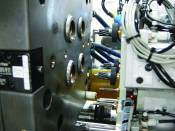Making Lean Work: Autonomation
Transferring human judgment to automated machinery can increase shop production.
What makes lean work? People of course! Jidoka (also known as autonomation) refers to adding human judgment to automated equipment and denotes a respect for people.
Jidoka is a strong part of lean manufacturing that can help maintain an assurance of top quality. This defect detection system automatically or manually stops the production operation and/or equipment whenever an abnormal or defective condition arises. Directing attention to the stopped equipment and the worker who stopped the operation forces improvements to be made immediately. The Jidoka system shows faith in the worker as a thinker and allows all workers the right to stop the line on which they are working.
A good example of Jidoka is the Toyota power loom developed in the early 20th century. A problem existed with shuttlecocks that would stick and create defects in the cloth being produced. Before power looms, a weaver would be able to remedy any such problems before proceeding, but power looms continued mindlessly on, producing unacceptable quality that required the cloth to be unraveled and backed up, boosting costs and making quality suspect. The Toyota loom incorporated a simple stopper that was activated by a sticking shuttlecock, and thus the machine became more human, and knew when to stop. The end result was a reliable system that was cheaper to operate and produced the expected quality. Jidoka prevents products with unacceptable quality from continuing in the process.
The Old and the New
In the old smokestack factory, where machines built enormous piles of inventory, the worker was there as an attendant to watch the machines, to load and unload materials, to make adjustments and ensure that the machines were operating efficiently.
In the new lean machine cells the worker also loads the machine with material, but the machine is capable of holding the part while it is working on it. Visualize this as you manufacture your mold: the worker loads a piece of material into a machine, and the machine holds and automatically creates the part. The worker then picks up the part, which was completed in an earlier cycle, and takes it to the next machine where a fixture can hold the part to be further worked on. The worker then walks around the cell loading, unloading, looking at the part and ensuring the accuracy of the process.
In the old system the worker loaded the machine then just stood there and watched. In the lean system it is the reverse logic, the machine can stand idle, but the worker continually moves.
When operators are alerted to variability in quality and machine performance, and when they detect an actual problem that is occurring, they have the ability to alter the manufacturing process (even to the extent of stopping their machine).
Example
At a Toyota factory there are large light boards with numbers hanging from the ceiling. Whenever a worker detects a problem, they are encouraged to pull a string or press a button that causes a yellow light to go on, which can be seen by almost every other worker in the plant. This yellow light alerts the supervisors and other managers of a potential problem. If the problem was unsolvable for the worker, he/she would again pull the cord or hit a button, which would cause red lights to go on, an alarm to go off and all the machines in the factory would stop. The supervisors and other workers would then run over to help. From these lights they know exactly what process is in trouble. Thus one worker in trouble could stop everyone else in the plant from working.
The Jidoka system forces supervision, management and the worker to get to the root cause of the problem so that it does not occur again. By applying this type of pressure on people, defects and problems are driven down.
Jidoka Yields Increased Production
Imagine the power and respect this gives to every worker in the factory, with a policy that says we are willing to stop the entire plant from working rather than allow a single defect to be passed onto the customer. Mold manufacturers should consider implementing Jidoka (autonomation) to allow their workers to stop the mold build process whenever they detect a problem or a potential problem. Separating your workers from their machines will make them more productive.
Related Content
Developments in High-Speed Machining Technology
There have been many exciting developments in high-speed machining relative to machining centers and controls, tooling and CAD/CAM systems.
Read MoreDesign Strategy Tackles Big and Small Complexity Challenges for Southeastern Mold Builder
Delta Mold Inc.’s core values, engineering expertise, five-axis machines and molding capabilities help the team turn a proposal into a manufactured mold or part with custom design, finishing and assembly.
Read MoreThe In's and Out's of Ballbar Calibration
This machine tool diagnostic device allows the detection of errors noticeable only while machine tools are in motion.
Read MoreSpeed, Productivity Gains and High Uptime Ease Decision for Second Five-Axis Machine
Byrne Tool + Design reduced setups and gained speed and productivity thanks to fast, accurate and compact five-axis CNC machining centers.
Read MoreRead Next
Mold Design Tips for Automation
Automation suppliers can assist mold manufacturers with proper mold design and engineering before cutting steel for new molds. Hot runner molds, cold runner molds, box filling, insert molding, stack molds and multi-component molding are areas that can be built and managed more inexpensively, reliably and simpler.
Read MoreReasons to Use Fiber Lasers for Mold Cleaning
Fiber lasers offer a simplicity, speed, control and portability, minimizing mold cleaning risks.
Read MoreHow to Use Strategic Planning Tools, Data to Manage the Human Side of Business
Q&A with Marion Wells, MMT EAB member and founder of Human Asset Management.
Read More.png;maxWidth=970;quality=90)








_300x250 3.png;maxWidth=300;quality=90)




.png;maxWidth=300;quality=90)
.jpg;maxWidth=300;quality=90)







